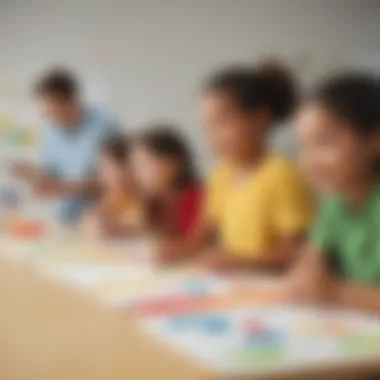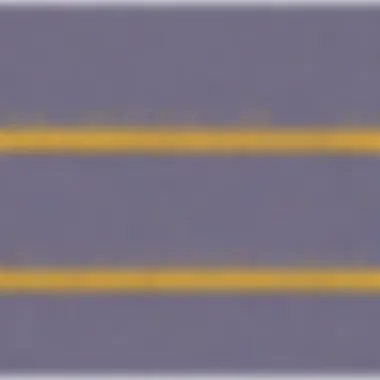Exploring Fractions on an Interactive Number Line


Intro
Fractions are an essential component of mathematics, especially for elementary school children. Understanding fractions can help develop strong mathematical skills that are useful throughout life. One effective way to grasp the concept of fractions is through the use of an interactive number line. This tool not only visualizes fractions but also makes learning engaging and enjoyable.
In this article, we will explore the significance of fractions and how they can be represented on an interactive number line. We aim to provide children, as well as their parents and caregivers, with a comprehensive understanding of key concepts such as identifying, adding, and subtracting fractions. The approach is not just theoretical; it integrates practical methods designed to nurture a love for mathematics.
Key Points to Discuss
- What fractions are and their relevance in daily life.
- How to effectively use a number line to visualize fractions.
- Methods for teaching the addition and subtraction of fractions using an interactive number line.
- Fun creative activities and quizzes to reinforce learning.
- Additional resources for parents and educators.
By the end of this exploration, we hope to cultivate a solid foundational understanding of fractions, setting the stage for more advanced mathematical concepts.
Understanding Fractions
Fractions serve as a foundational concept in mathematics, particularly important for elementary school children. Understanding fractions aids in recognizing parts of a whole and fosters important skills in numerical literacy. In the context of this article, comprehending fractions is essential for integrating them with an interactive number line. It not only enhances a child’s mathematical skills but also builds confidence and curiosity in engaging with math concepts.
Definition of Fractions
A fraction represents a part of a whole. It consists of two main components: the numerator and the denominator. The numerator, found above the line, indicates how many parts are considered, while the denominator, located below, shows how many equal parts the whole is divided into. For instance, in the fraction 3/4, three parts out of a total of four equal parts are being represented. This definition is fundamental as it establishes the basis of further operations involving fractions.
Types of Fractions
Understanding the different types of fractions is crucial for children as it enables them to categorize and manipulate various fractional forms effectively. Here are the main types:
Proper Fractions
Proper fractions are those where the numerator is less than the denominator, such as 1/2 or 3/8. This type is particularly important because it fits the concept of parts of a whole. The key characteristic is that they always represent a quantity less than one. In this article, proper fractions are beneficial as they help children visualize and comprehend simple fractions through an interactive number line. They offer a clear representation of smaller portions, making it easier for young learners to grasp the foundational concepts of fractions.
Improper Fractions
Improper fractions occur when the numerator is greater than or equal to the denominator, such as 5/4 or 3/3. They play a significant role in teaching children how to work with quantities that exceed one whole. A unique feature of improper fractions is that they can often be converted into mixed numbers. While they may seem more complex, they are essential for mastering the concepts of fractions. By exploring improper fractions on an interactive number line, students can better understand how these larger quantities are represented and manipulated.
Mixed Numbers
Mixed numbers combine a whole number and a proper fraction, for example, 2 1/3. This type is particularly helpful in providing context to children about quantities that exceed whole numbers. The key characteristic of mixed numbers is their dual nature, which presents both a whole component and a fractional part. Incorporating mixed numbers into lessons allows children to see how fractions can coexist with whole numbers, enhancing their overall understanding. They are also essential in everyday scenarios, such as measurements in cooking or construction, making them relevant and practical.
The Number Line: A Visual Tool
The number line serves as a critical visual aid when teaching fractions, enhancing the understanding of all students, especially children. By representing numbers in a straight line, it provides a structured way of visualizing the relationships between whole numbers, fractions, and even negative numbers. This representation allows learners to see not only where fractions fit within the broader numerical range but also how they relate to one another. By integrating fractions on a number line, students can concretely grasp concepts that might otherwise remain abstract.
A number line is not just a static line; it evolves with the learning process. It helps learners visualize basic operations like addition and subtraction by showing how fractions can be physically moved or combined on the line. Such a tangible view reinforces learning, making otherwise complex fraction problems seem straightforward.
Consider the following benefits of using a number line:
- Clarity in Understanding: It provides a clear view of where fractions fall in relation to whole numbers.
- Foundation for Operations: Number lines illustrate how to perform operations involving fractions, giving students essential skills for future math.
- Flexible Learning Tool: Number lines can adapt to various teaching methods and styles, catering to visual learners as well as kinesthetic learners who benefit from physical movement along the line.
Ultimately, the number line is a multifaceted tool that facilitates deep understanding of fractions and prepares students for more advanced work in mathematics.
What is a Number Line?


A number line is a straight line with numbers placed at equal intervals along its length. It typically starts from zero and extends indefinitely in both directions, representing both positive and negative values. Fractions and whole numbers share this same line, allowing students to visualize how they coexist within the same numerical space.
On a basic number line, whole numbers like 0, 1, 2, and so on are marked. Between these whole numbers, fractions such as 1/2, 1/3, or 3/4 appear, filling in the gaps. This visual representation is crucial for students learning how fractions relate to whole numbers and each other.
History of the Number Line
The number line has a rich history that dates back to ancient civilizations. The concept of a linear representation of numbers has helped scholars and students alike throughout the ages. The earliest forms of number representation were seen in ancient Egypt and Mesopotamia, where concepts of numbers were inscribed using symbols. However, the formalization of the number line emerged in the 17th century.
René Descartes, a French mathematician, is credited with creating the Cartesian coordinate system, which linked algebra and geometry. This innovation influenced the development of the number line into a more sophisticated tool that could depict not just numbers but also points in space. In education, the use of number lines became more prevalent in the 19th century as teaching mathematics evolved to incorporate visual aids for better comprehension. Today, the number line remains an essential part of mathematics curricula around the world.
"The number line is more than just a teaching tool; it is a bridge between visual representation and numerical understanding, laying the groundwork for future mathematical endeavors."
Understanding the history of the number line enriches appreciation for its role in mathematics education. Students benefit by learning that this simple tool has deep historical roots and has drastically evolved over time.
Integrating Fractions with the Number Line
The concept of integrating fractions with the number line serves as a fundamental bridge that can connect abstract mathematical ideas to tangible visual forms. Understanding fractions is critical in early mathematics education. Being able to visualize fractions on a number line allows children to overcome common difficulties faced when learning about this topic. It lays the groundwork for advanced concepts and offers a clear strategy for mastering basic arithmetic.
A solid grasp of this integration helps children see that fractions are not merely numbers, but represent parts of a whole. This realization can aid in overcoming the common misconception where fractions are viewed as separate and distinct from whole numbers. Moreover, utilizing the number line allows each fraction to gain a unique position, which further communicates their intrinsic relationships to one another. By illustrating how fractions relate to whole numbers, it becomes evident that they are a continual, measurable concept.
Locating Fractions on the Number Line
Locating fractions on the number line is often the first step in making sense of their value and position. This involves representing fractions such as 1/2 or 3/4 on a line marked with whole numbers. To visualize this, one can imagine a number line stretched between 0 and 1. To find 1/2, you would mark the midpoint. Likewise, for 3/4, you would divide the segment between 0 and 1 into four equal parts and count three parts over from zero.
This exercise reinforces the understanding that fractions have distinct places. It also emphasizes that even though fractions are less than one, they occupy defined and measurable points on a continuum. As children practice this skill, it enhances their ability to comprehend relative sizes between different fractions.
Visualizing Fraction Additions
Visualizing fraction additions using the number line can simplify a concept that many find challenging. When adding fractions, such as 1/4 and 1/2, a child can first locate each fraction on the number line. Start by marking 1/4, then extend the line to add another 1/2.
In this example, 1/2 can be written as 2/4 for easier addition resulting in 3/4. Once this sum is reached on the number line, it becomes clear how fractions build upon one another. This visual representation of addition also helps clarify what it means to combine different fractions, facilitating a more intuitive understanding of the process.
Visualizing Fraction Subtractions
Similar to addition, visualizing fraction subtraction on the number line is equally valuable. To subtract fractions, you can again mark their locations. Let’s take the example of 3/4 minus 1/4. First, find 3/4 on the number line. From this point, moving left by 1/4 demonstrates the subtraction clearly. You would end up at the position of 1/2.
This method works effectively in showcasing the operation of subtraction. As the child moves along the number line, they gain insight into decreases and increases in value. It shows that subtraction of fractions, like whole numbers, is simply a matter of navigating a defined space. The practicality of this visual method can transform a seemingly daunting task into an approachable and understandable one.
"Understanding the movement on a number line can turn abstract mathematical ideas into clear visualizations for young learners."
In summary, integrating fractions within the realm of the number line is not only a strategy for enhancing understanding but also fosters critical skills necessary for future mathematical endeavors.
Interactive Number Line Tools
Interactive number line tools serve as a crucial component in the journey toward understanding fractions. These tools facilitate visual and hands-on engagement, making abstract mathematical concepts more tangible for elementary school students. In this digital age, where interactivity takes precedence, using interactive number lines can cater to various learning styles. Students have the opportunity to learn by doing, which often leads to better retention and comprehension.
Key Benefits of Interactive Number Line Tools:
- Visual Learning: Interactive tools help children visualize fractions clearly. Traditional methods may not offer enough clarity when dealing with fractions. A dynamic visual representation allows children to see how fractions are positioned on the number line, making the concept less intimidating.
- Engagement: Engaging with interactive features can enhance a child's motivation to learn. They can manipulate the number line, add or subtract fractions, and witness their results instantly.
- Personalized Learning: These tools provide the flexibility to tailor learning experiences. Each child can learn at their own pace, reviewing sections or focusing on challenges uniquely suited to their needs.
Nevertheless, when implementing these tools, educators and caregivers should consider several factors. Selecting an appropriate tool that aligns with the curriculum is essential. Furthermore, it's critical to provide guidance on how best to use these resources. While children may find joy in the gameplay aspect, guidance ensures that they remain focused on learning.


Overview of Interactive Tools
Interactive tools designed for number line learning typically feature diverse functionalities. They may include interfaces where students can click, drag, and drop fractions onto specific points on a number line. This offers a way for children to experiment with their understanding of both fractions and numeric relationships.
Some interactive tools go beyond basic functions, incorporating games and challenges that reinforce learning. Through competition or collaborative activities, students can share insights and learn from peer interactions. These supportive environments foster a healthy love for numbers and mathematical thinking.
Popular Interactive Number Line Applications
Several applications and platforms have risen to prominence in the realm of interactive number lines. Here are a few noteworthy mentions:
- IXL Learning: Offers comprehensive math tools, including number line activities tailored to various fraction concepts.
- Khan Academy: A well-known platform that provides interactive math tools along with instructional videos to deepen understanding.
- Toy Theater: This website provides a digital number line that children can manipulate easily. It offers a range of visual representations.
- Math Playground: A platform that combines number lines with engaging games to help children practice fractions in a fun setting.
"These applications can transform the way children perceive and interact with fractions, making the learning process both effective and enjoyable."
Using these tools can ensure that the mathematics education process is dynamic, engaging, and comprehensive. Families and educators should explore these resources to help young learners develop robust foundational skills in mathematics.
Benefits of Interactive Learning
Cognitive Development Through Interactivity
Engaging students with interactive tools promotes cognitive development. When children manipulate elements on a number line, they begin to form connections between concepts
- They can visualize fractions as parts of a whole.
- They experience the relationships between different fractions and their decimal equivalents.
- They can grasp the concept of equivalency more fully.
These practical interactions help solidify foundational math skills and enhance critical thinking abilities. Research supports the idea that active participation leads to a deeper understanding of concepts. Moreover, when children experiment with these tools, they can learn through trial and error, reinforcing their understanding in a natural way. The observable actions taken when they adjust fractions on the number line clarify how quantities relate to each other.
Engagement and Motivation in Learning
Incorporating interactive elements into lessons significantly enhances student engagement and motivation.
- Children feel more inclined to participate when they can engage with technology or hands-on materials.
- Interactive tools often include immediate feedback, allowing students to see the results of their actions instantly.
- Games and challenges designed around fraction use elevate motivation, turning what could be a mundane task into a fun exercise.
Engagement leads to motivated learners. Enthusiastic participation in activities that involve fractions can cultivate a more positive attitude toward mathematics overall. This shift is crucial; research indicates that a positive outlook toward mathematics in early years can lead to increased proficiency as students progress in their education.
"Interactive learning tools transform complex math concepts into manageable, enjoyable tasks that stimulate children’s thinking processes and deepen their understanding."
By focusing on the benefits of interactivity, this article illustrates how engaging tools contribute significantly to a child's education in mathematics.
Practical Applications of Fractions
Understanding fractions is not just an academic exercise. It has vital practical applications that influence various aspects of daily life. Learning to use fractions effectively enhances problem-solving skills and helps children relate what they learn in class to real-world situations. This section discusses how fractions come into play in everyday activities, enriching children’s understanding of the subject and bolstering their mathematical abilities.
Using Fractions in Real Life
Fractions are everywhere in real life. They are used in cooking, shopping, and even in measuring distances. For instance, when a recipe calls for half a cup of sugar, it is applying the concept of fractions directly. Children can see that fractions help measure out ingredients correctly, making cooking an engaging and educational experience.
Shopping also frequently involves fractions. If an item is on sale for one-quarter off its original price, understanding how to calculate the sale price requires knowledge of fractions. Children learn to apply their mathematical skills practically, reinforcing their understanding.
Here are some common scenarios where fractions are useful:


- Cooking: Recipes often use fractions to denote amounts.
- Shopping: Discounts frequently involve calculating fractions of prices.
- Time Management: Scheduling events may involve understanding half-hours or quarters of hours.
"Fractions are essential tools that help us navigate common daily tasks efficiently."
Understanding these situations helps children grasp the relevance of fractions. Parents and caregivers can create opportunities for children to use fractions actively in daily life—like cooking a meal or planning an outing. This boosts their confidence and mathematical skills, making use of fractions more relatable.
Games and Activities for Learning Fractions
Games and activities make learning about fractions much more enjoyable for children. Interactive activities engage the senses, allowing children to explore concepts in a fun environment. Here are some ideas for games and activities that focus on fractions:
- Fraction Puzzles: Use pie charts or fraction circles to assemble fractions visually. These aids make it easier to understand how different fractions compare.
- Cooking Together: Involve children in the kitchen and have them measure ingredients. This hands-on experience can solidify their understanding of parts of a whole.
- Fraction Bingo: Create bingo cards with various fractions. Call out fraction values, and children can place markers on their cards when they recognize a match. This game encourages recognition.
By integrating fractions with games and fun activities, children will associate learning with positive experiences. They will likely retain concepts better and feel more motivated when it comes to practicing fractions. Active engagement is key to fostering an enduring understanding of mathematics.
Challenges in Understanding Fractions
Understanding fractions can be a daunting task for many elementary school children. This difficulty often arises from various misconceptions and hurdles that learners encounter. Addressing these challenges is essential because a solid understanding of fractions provides a foundation for future mathematical concepts. By tackling these obstacles, we equip students with the necessary tools to enhance their mathematical reasoning and confidence.
Common Misconceptions
Fractions are frequently misunderstood. Some common misconceptions include the following:
- Numerator and Denominator Confusion: Children might think that the numerator is always larger than the denominator. This is especially true with improper fractions and mixed numbers.
- Fraction Size: Many students believe that a larger numerator or denominator indicates a larger fraction. For example, they might think ( \frac32 ) is smaller than ( \frac23 ) without understanding the context of the number line.
- Whole Number Association: Another misconception is associating fractions only with whole numbers. Children may struggle to see fractions as distinct entities that have their own value and significance.
These misconceptions can lead to confusion and frustration, which is why it is crucial to address them early. Recognizing these misunderstandings allows educators, parents, and caregivers to intervene and guide children toward a clearer understanding of fractions.
Strategies to Overcome Challenges
To successfully navigate the challenges in understanding fractions, several strategies can be employed:
- Use of Visual Aids: Incorporating visual tools like number lines can help children better understand the placement and value of fractions. When children visually see how ( \frac12 ) sits between 0 and 1 on a number line, it clarifies their misconceptions about size and value.
- Hands-On Activities: Engaging children in activities that involve physical items, such as cutting a pizza or pie into fractional parts, can solidify their understanding. This makes fractions tangible and relatable.
- Fraction Games: Using games that focus on fractions can make learning enjoyable while reinforcing important concepts. Online platforms often incorporate interactive number lines that promote engagement.
- Consistent Reinforcement: Regular practice is vital. Revisiting concepts and providing various problems helps to solidify understanding and dispel lingering misconceptions.
Adopting these strategies empowers children to approach fractions with confidence. With the right tools and understanding, they can confront challenges more effectively, leading to a more enriching learning experience in mathematics.
Future of Learning Fractions
In an ever-evolving educational landscape, the teaching of fractions holds significant promise and relevance. The Future of Learning Fractions is largely defined by advancements in technology and innovative educational practices. These elements together are reshaping how we approach mathematical concepts, particularly for elementary school children. The ability to grasp fractions is foundational to understanding more complex mathematical principles, making this area of learning crucial for ongoing educational success.
Emerging Technologies in Mathematics Education
Emerging technologies are playing a transformative role in mathematics education. Tools such as interactive number lines, educational apps, and virtual learning environments provide dynamic ways for students to engage with fractions. With the rise of digital resources, children can visualize fractions through interactive experiences. This ongoing interaction can enhance spatial and numerical skills.
Current advancements offer access to a plethora of resources. For instance, platforms like Khan Academy and IXL provide tailored exercises and immediate feedback on students' performance. Additionally, augmented reality applications make the learning of fractions more tangible. These technologies empower students to explore mathematical concepts in two-dimensional and three-dimensional formats.
Some benefits emerge from integrating these technologies:
- Increased Engagement: Multimedia resources foster curiosity and participation.
- Real-Time Feedback: Students can immediately see their mistakes and learn from them.
- Flexible Learning: Technology accommodates various learning styles, allowing learners to progress at their own pace.
The Role of Educators in Teaching Fractions
While technology plays a pivotal role, the influence of educators remains paramount in teaching fractions effectively. Teachers are tasked with guiding students through the complexities of fractions, offering support and fostering understanding. Their ability to connect with students and adapt to their needs can profoundly impact their mathematical journey.
Educators must stay informed about new tools and methods for teaching fractions. Professional development and collaboration among teachers can lead to improved practices. Incorporating strategies such as hands-on activities, discussions, and visual aids can cater to different learning styles among students.
Moreover, fostering a growth mindset can encourage students to embrace mistakes and view challenges as opportunities for growth. This approach helps build resilience and confidence in their mathematical skills.
In summary, the future of learning fractions embraces both technology and teaching strategies to create a comprehensive educational experience. With the right balance, we can equip children to not only understand fractions but also to apply them confidently in real-world situations.







